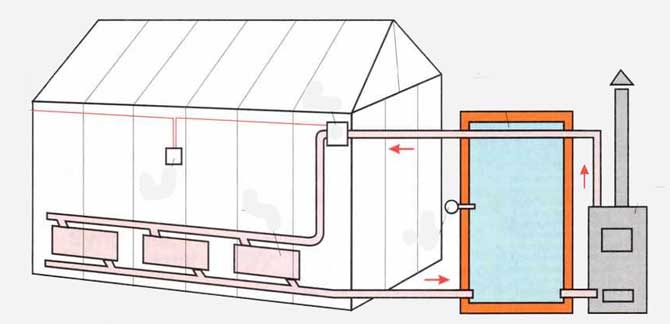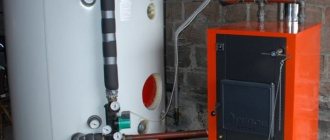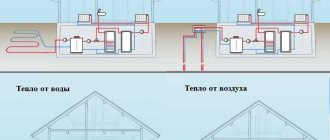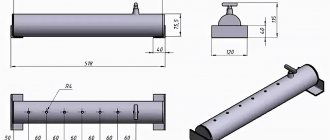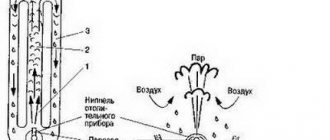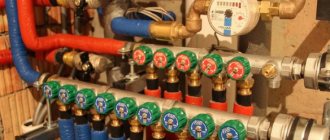How to heat a greenhouse in early spring?
Considering the options for heating the greenhouse in winter, one must remember the following important points:
- The temperature inside the greenhouse should never exceed 40 ° C. Excessive heat can simply dry out the plants.
- To heat each cubic meter of indoor space, the selected heating device must produce 100 W of heat.
- Soil heating is ideal for heating. If heat exchangers are used, then they must be located at the lowest possible height.
The easiest and most natural way is with the sun. To use the energy of the heavenly body to the maximum, the greenhouse should be placed in the place on the site where the most sunlight falls - this way the plants will receive the maximum amount of heat and light.
Experienced gardeners have found that it is best to heat a greenhouse in the form of an arch or a hemisphere in the sun.
For solar heating to work effectively, the greenhouse roof must be completely transparent. Then the sun's rays will be able to freely pass inside and heat the plants and soil, which will give off heat, thereby heating the air in the greenhouse.
The undoubted advantages of the solar heating method are efficiency and environmental friendliness, but a significant disadvantage is the fact that this option is not suitable for the northern regions.
It is not necessary to use any kind of heating to grow seedlings and early summer produce. To do this, it is enough to make greenhouse beds on overheated manure. It is necessary to remove the fertile soil layer, instead of the beds, trenches will turn out. It is advisable to make boards for future warm beds from boards or other materials at hand.

When it's still cold outside, you can stretch the film onto the greenhouse with a second layer. An air lock will form between the main layer and the additional layer, which will also retain heat. The greenhouse should be positioned so that it stays in the sun for as long as possible. The sun's rays will penetrate the foil or cellular polycarbonate and heat the surface of the ground in the greenhouse.
But there are downsides. If you do not have your own manure, then you have to buy it, and now this is quite an expensive pleasure. In addition, it must be stored in the fall. And do the ridges every spring anew. This is a very time consuming process. DIY heated greenhouses are not easy to do. And in winter there will be little such "heating".
In order for the greenhouse business to be profitable, it is necessary not only to heat the greenhouse well, but also to use all possible means to preserve this heat as best as possible.
For this, it is good to apply all knowledge in a complex. Well-chosen location for building a greenhouse, no shade, all day under the sun. The greenhouse should be located so that the wind does not blow out the heat. Nice, warm foundation. The greenhouse cover is better made of cellular polycarbonate. There should be no gaps in the structure: in winter, in frost, any draft is destructive.
You can use warm tall beds with manure, which will also accumulate heat. You can grow seedlings on shelves. It is good to combine heating of the greenhouse: increase the temperature of the air and soil. By the way, waterproof mats can be used for the effect of underfloor heating. It is convenient to use them in greenhouses with shelving, placing heating mats under them. The heat always rises up from the bottom, heating the trays with plants and the air.
Heating the greenhouse: ways
How to heat a greenhouse in winter? Now there are many ways to make in a greenhouse heating do it yourself. Each of them has its own advantages and disadvantages, therefore, in order to choose the ideal option for heating the greenhouse do it yourself, you need to pay attention to the following selection criteria:
- greenhouse size;
- financial opportunities;
- climatic features of the region;
- the need of different greenhouse plants for heating.
Heated winter greenhouse - projects, photo:
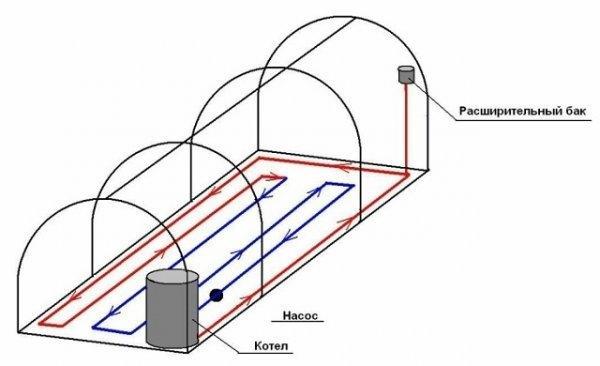

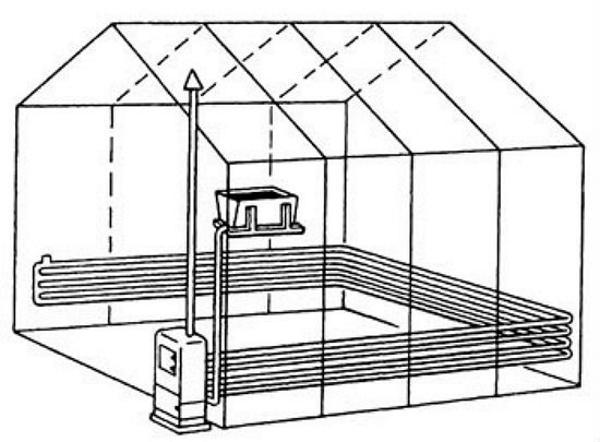

Solar
This is the most natural way of heating... In order for the sun to heat the greenhouse better, you need to place it in the sunniest place and choose a suitable covering material. The ideal coverage is considered glass.
The sun's rays pass through the coating, heat the earth and the air. Heat is returned much weaker due to the density of the structure and the covering material. A greenhouse in a mold heats best hemispheres or arches.
Advantages:
- profitability;
- environmental friendliness.
Disadvantages:
- in winter, this method can only be used in the southern regions;
- temperatures can drop dramatically at night, killing plants.
Electric
How to heat a greenhouse in winter? The next way to heat a greenhouse in winter is electric... For a small and sealed facility, this would be ideal.


There are different ways
electric heating greenhouses in winter:
- convection systems;
- water heating;
- infrared heating;
- heaters;
- cable heating;
- Heat pump.
Greenhouse heaters have different mechanism of action.
The common advantage of such structures is that they react to temperature changes and automatically create ideal microclimate... With the correct placement of electric heaters, the greenhouse will heat up evenly, which will significantly improve plant growth.
Advantages:
- profitability;
- mobility (most of these devices can be adjusted to the parameters of any greenhouse);
- ventilation.
Disadvantages:
- with a shortage of heaters, the air will warm up unevenly;
- the possibilities of heating the soil are very limited.
Read on our website about how to make a drip irrigation system, a hydraulic cylinder for greenhouses with your own hands, and what thermoregulation is for.
Air
System air heating installed during the construction of the greenhouse. Its installation is very difficult, so a specialist must deal with this matter.
How to make greenhouse heating? Special heating and ventilation devices are installed in the base of the foundation and in the frame of the building, which distribute warm air at the top of the greenhouse. Thanks to this, the hot air does not get on the plants themselves and does not burn the delicate leaves of the seedlings.
To heat the soil, you can install around the perimeter of the greenhouse perforated heating sleeve.
Winter greenhouses with heating - photo:
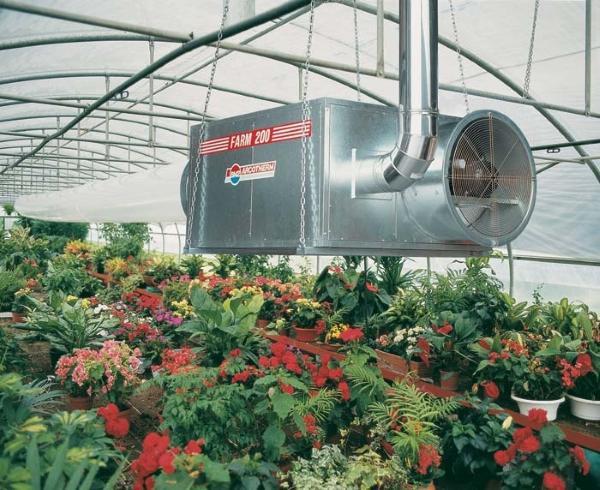

Underfloor heating system
With the help of a "warm floor" you can heat the soil. Such a system can be made for heating the greenhouse in winter with your own hands. Installation of the structure is simple: you need to remove part of the soil, fill the trenches with sand, put a layer of heat-insulating material, lay the cable with a snake and again fill it with sand and soil.
This system allows save on installation and operation. In addition, its advantage is the ability to automatically regulate the heating and distribute heat evenly throughout the greenhouse.
Biological
Villagers still use the easiest way to heat greenhouses - biological... In this case, heat is released due to the decomposition of organic substances by microorganisms. Horse manure is usually used as a heating substance, since it is able to reach temperatures in 60–70 ° C for a week and keep it up to 120 days.
Advantages:
- the air of the greenhouse is saturated with carbon dioxide, useful for plants;
- manure also serves as fertilizer;
- due to vapors, the air and soil are constantly humidified.
Disadvantages:
- in the southern parts Of Russia this method is suitable for winter, but for Ural it is advisable to use it only in the spring;
- horse manure is difficult to find, and other organic substances (compost, garbage) take longer to heat up and lose heat earlier.
Making a bed of manure is easy: you need to remove all the earth from it, fill it with horse manure on 1/3, and then lay out the soil again.
Stove
How to heat a greenhouse in winter? Stove heating has long been used by garden owners.
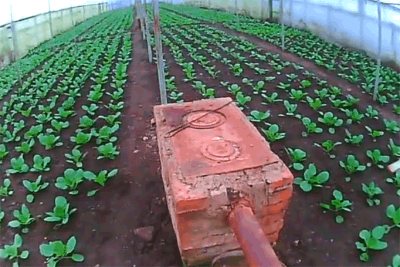

In winter, an ordinary stove stove can maintain the optimum air temperature in the greenhouse for a long time - about
18 ° C.
However, this method is only suitable for southern regions of Russia: such a stove cannot cope with Siberian frosts.
Dignity stove heating is economical: materials for a stove-stove are relatively inexpensive and installation is easy to carry out with your own hands.
Heat can be obtained using any solid fuel - firewood, coal, sawdust, rags, packaging materials. The resulting waste, ash and ash, can be used to fertilize the beds.
Disadvantages of stove heating:
- the air does not always warm up evenly: a high temperature zone forms next to the stove, in which plants can die;
- stove-stove - a fire hazardous structure, therefore, you need to be especially careful about thermal insulation;
- laborious heating process: the structure will function properly only if fuel is regularly tossed into the stove.
You can read about how to equip a greenhouse here. And also in the article how to build a winter greenhouse with heating.
Arrangement of a year-round greenhouse
For a long time there have been ready-made greenhouse structures on sale with the provided high-quality heating. It is necessary in harsh climatic conditions for both farmers and private traders. If you wish, you can prepare a regular greenhouse for use in the winter.
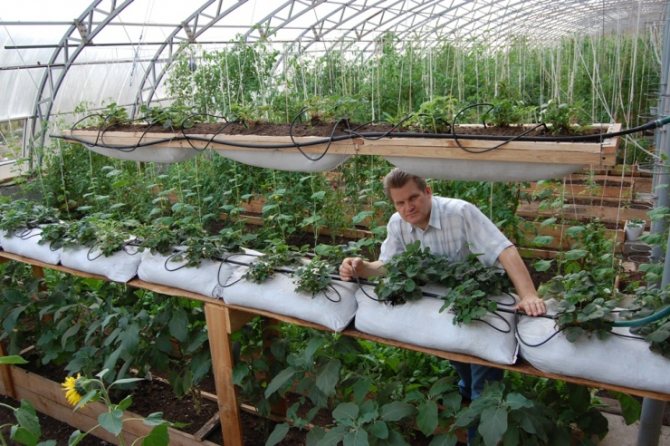

Heating in a greenhouse will help grow crops in winter
It is advisable to insulate the base so that hypothermia of the soil does not lead to a decrease in yield:
- The foundation can be a wooden platform. It is treated with an antiseptic and covered with a waterproofing material.
- The second option is pouring with concrete with further foam insulation.
Glass perfectly transmits light, but its weight and inability to bend complicates installation, and its high thermal conductivity does not allow maintaining a stable temperature throughout the day. Polycarbonate greenhouses are the highest quality designs for year-round use. Having made heating in a polycarbonate greenhouse with your own hands, you can be sure of good early harvests.
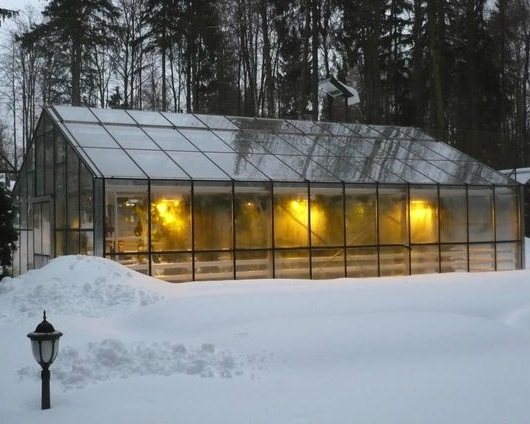

Polycarbonate panels are one of the best materials for creating greenhouses, including year-round ones. This material is strong enough and is not subject to the destructive influence of the external environment (for example, temperature drops, high humidity).
At the same time, it is very convenient to work with such material - it is mounted on the frame of the greenhouse using self-tapping screws, it bends well.
The most important advantage of such greenhouses is the ability to use it all year round, grow plants all the time and receive fruits. It can be both a variety of greens and other vegetables.
Having installed all the necessary systems, you can create any necessary temperature conditions inside. In addition, the greenhouse does not need to be cleaned after every season.
It is a building that can be used for many years with proper maintenance.
Read next: The best electric home heating: expert tips and tricks
Stove heating
How to heat a greenhouse without gas and electricity? Stove heating is one such method.They make an ordinary stove, from it horizontally they let a chimney along the walls of the greenhouse. It should gradually rise up and finally be brought out. This will heat the greenhouse. The firebox must be made so that it opens outside the greenhouse, because it is impossible for soot and smoke to penetrate into it. Then the quality of the vegetables will suffer.
You can install a stove with a boiler in which water will be heated, and then it will circulate through pipes that will be laid on the ground along the length of the greenhouse. Hot water will heat the air.
If the efficiency of such systems can satisfy the user, then the laboriousness of the process is very tiring. The fact is that you need to constantly monitor the temperature, often throw up solid fuel. Not everyone can quit their job and be a stoker in their greenhouse all winter. And is it worth it?
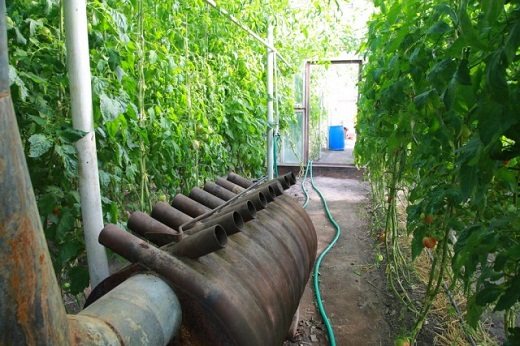

When constructing heated greenhouses with your own hands, it should be borne in mind that the film and glass do not keep heat well, and therefore they need to be better heated. Cellular polycarbonate, due to its design, keeps heat well, and therefore the cost of heating will be less.
Heating with heat generating boilers is also a good sight. Unlike simple stoves, the heat generator with solid fuel needs to be charged no more than 2 times a day. There are diesel fuel systems. The efficiency of such heating is not the highest.
Greenhouse solar heating (solar air collector)


To create such a system, it is necessary to consider the location of the air manifold in order to ensure air circulation. In order for the air masses to move independently, the inlet must be positioned higher than the outlet. Then the warm air will rise and enter the greenhouse, and the cooled air will return back to the collector, there it will warm up and repeat the cycle.


Friends! As part of our portal, we launched a book on how to make a lawn with your own hands. If this topic interests you, then READ MORE >>
If, however, to organize air circulation forcibly, it is necessary to install fans near the inlet. Thus, the soil will warm up more evenly.
To keep the air warm at night, an additional circuit is needed, for which a fan heater can be used.
It is not difficult to make a collector. To do this, you need to assemble a box of fiberboard, the height of which should be about 15 cm. You can strengthen it with stiffeners. A layer of mineral wool should be placed on the bottom, which should be covered with an absorber.
All seams must be sealed and the inner surface painted black. The sides must be equipped with pipes through which air will enter and exit. Then the box is closed with tempered glass and the joints are again treated with a sealant.
The box is fixed on the roof, the air ducts are directed into the holes in the walls of the greenhouse. You can supply several similar collectors. The air temperature in them will be about 50 degrees.
https://youtu.be/BFO98DVrFd4
What should be the greenhouse?
All greenhouses work in a similar way. Winter greenhouses have some features that must be observed during construction.
A winter polycarbonate greenhouse is a stationary building and requires the creation of a high-quality foundation and a solid frame.
A prerequisite for creating a year-round greenhouse is a capital foundation. A wooden foundation will not work, because it needs to be changed periodically.
The best option is a concrete, brick or block foundation. The strip foundation is created along the perimeter of the structure, it is quite simple to install and at the same time relatively inexpensive.
The second important point is the greenhouse frame. Winter use assumes periodic snowfalls.The accumulation of snow on the roof leads to very strong loads on the frame, which can lead to the destruction of the entire structure. The frame can be made of wood or metal.
Both materials are susceptible to destruction and will require preliminary preparation, and in the future - prophylaxis and periodic replacement of unusable elements.
Preparation for construction
On the network you can find a lot of ready-made solutions for the construction of greenhouses and adapt them to your needs. You can also create your own drawing based on your needs and wishes.
There are special programs for creating drawings. They allow you to see the finished model of the future building.
In any case, when creating a greenhouse with your own hands, you need to pay attention to several factors.
First of all, you need to choose a place for further construction. You need to choose based on three main factors:
- Illumination. The greenhouse should receive the maximum possible amount of solar energy.
- Wind conditions. Strong and gusty winds are not only the risk of collapse of the structure, but also large heat losses. Therefore, wind protection is necessary. For example, you can place a greenhouse next to the wall of the house or plant low perennial plants at a distance of 5-10 meters.
- Convenience. Access to the heifer should be wide enough and convenient, which will greatly facilitate the maintenance of the building.
To maximize the amount of sunlight, the greenhouse can be positioned along its length from west to east.
Then you need to choose the shape of the roof of the future structure. Most often it is a gable or arched roof.
The shape of the roof should resist the accumulation of snow during the cold season. The gable roof is the easiest to install.
The material of the frame is also important. The strongest and most durable material is metal.
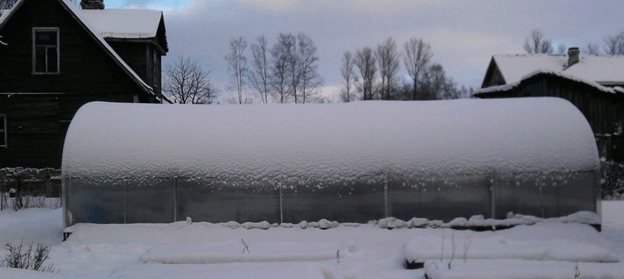

But it is important to remember that the creation of a metal frame will require welding to erect the structure. On the other hand, the tree does not require special tools or skills, it is quite affordable.
And if you additionally open it with several layers of paintwork, then it can serve for many years. By slightly strengthening the structure, you can achieve high strength and stability.
It is also worth mentioning the choice of polycarbonate. What is the required thickness of polycarbonate for a winter greenhouse? If a fairly thin sheet (6-8 mm) is suitable for an ordinary greenhouse, then panels with a thickness of at least 8-10 mm are needed for winter greenhouses. Otherwise, there is a risk that the panels will not withstand the load, and the heat will be poorly retained inside the building.
One of the key features of a winter greenhouse is a heating system. What kind of polycarbonate greenhouse heating to choose in winter? How to make heating in a polycarbonate greenhouse in winter with your own hands? How to heat and insulate a polycarbonate greenhouse for the winter with your own hands using stove heating?
Heating with electrical appliances such as infrared heaters is becoming more and more popular. How to arrange heating of a polycarbonate greenhouse with infrared heaters?


Installing such a system is very simple - you just need to connect the electrical network to the greenhouse and connect the electrical appliance. You will need to spend money on the heater itself and electricity.
Infrared polycarbonate greenhouse heaters are installed on the ceiling and are capable of providing an air temperature inside up to 21 degrees Celsius, and a ground temperature up to 28 degrees.
Read more: Purpose and connection diagrams of a thermostat for a heating boiler
The alternative is the old and traditional stove heating method.
It is much cheaper and easier to install. However, its disadvantage is the strong heating of the walls; it will not be possible to grow plants near it.
Finally, the foundation of the entire building must be made capital and stable, because the strength of the entire structure depends on it. Its creation does not require any complicated steps and can be done by anyone.
Construction work must be carried out in dry weather with a positive temperature.
Greenhouse furnace heating
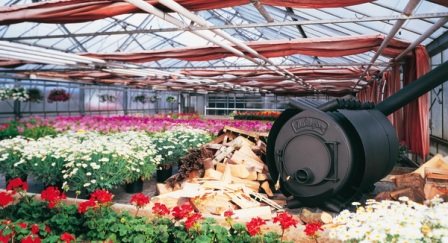

Greenhouse furnace heating
Traditional stove heating is characterized by high efficiency and relatively simple arrangement. For example, you can build a stove with a horizontal chimney without much financial investment.
First step. Lay out the stove in the vestibule of your greenhouse. Traditional brickwork is being carried out.
Second step. Lay a chimney under the beds or along the length of the greenhouse. It can also be laid under the shelving.
Step three. Run the chimney through the greenhouse wall. Consider the placement of the pipe so that it can effectively remove the combustion products, while passing over areas that need heating.
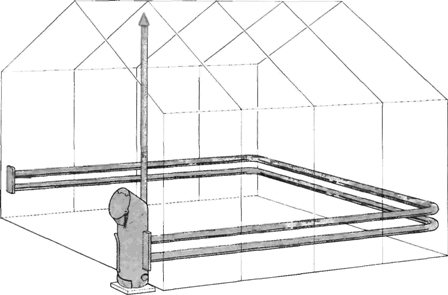

Furnace heating system in a greenhouse
Place the stove in such a way that its firebox is at a distance of at least 25-30 cm from the end wall of the greenhouse.
You can also make a stove from a metal barrel.
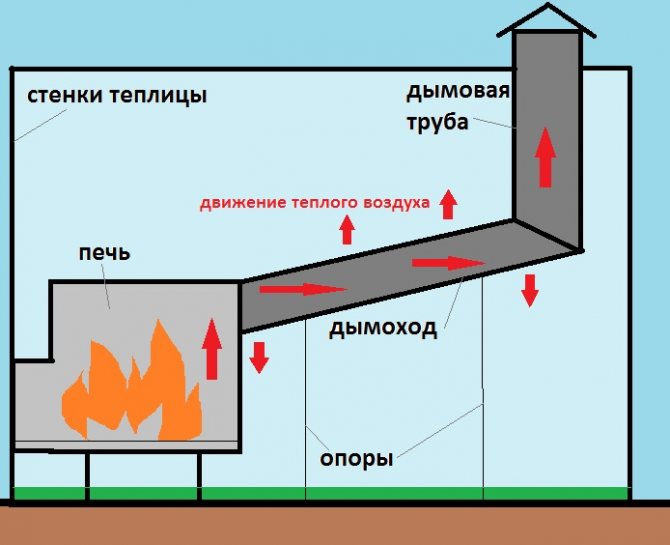

The principle of operation of a stove for a greenhouse
First step. Prepare a metal drum with a volume of about 250 liters. Cover the inner walls of the container with two coats of paint so that the material does not rust.
Second step. Mark and cut openings for the stove, chimney, drain valve (installed at the bottom) and expansion tank (located at the top).
Step three. Weld the stove (usually a rectangular structure made of sheet steel according to the dimensions of the barrel) and place it in the container.
Fourth step. Take the chimney out of the barrel. The length of the "street" part of the pipe must be at least 500 cm.
Fifth step. Attach the expansion tank to the top of the barrel. You can buy a ready-made container or weld it yourself from sheet metal. A 20-25 liter tank will suffice.
Sixth step. Weld heating units of suitable length from profile pipes measuring 400x200x15 (be guided by the size of the greenhouse). The pipes themselves must be laid on the ground in increments of about 120-150 cm.
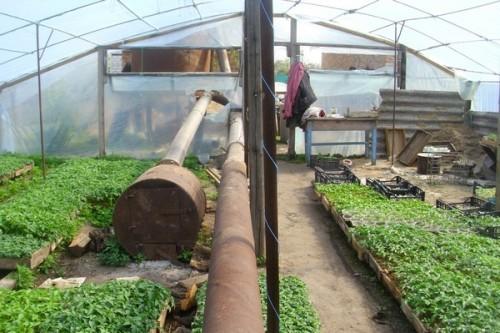

How to make greenhouse heating with your own hands
Seventh step. Buy and install a hydraulic pump. The system will be heated using water, so a pump cannot be dispensed with.
Any firewood is suitable for such a stove. For maximum efficiency, install an electronic temperature sensor in the greenhouse, and for greater convenience, place a digital control panel in the house or other suitable place.
With a heated greenhouse, even in winter, it is satiated and calm
Instructions
How to build a polycarbonate winter greenhouse with your own hands?
- Creation of the foundation.
- Installation of the frame.
- Installation of communications.
- Installation of polycarbonate panels.
For a stationary greenhouse, a strip foundation will be optimal. To install it, you need to dig a trench about 30-40 cm deep around the perimeter of the future building. A small layer of gravel and small stone (5-10 cm thick) is poured onto the bottom. Then the entire trench is poured with a layer of concrete.
When creating a mortar, a mixture of one part of cement and three parts of sand will provide the best quality.
After the solution has frozen, you can proceed to the installation of the next layer. A layer of waterproofing is laid on the foundation layer (roofing material is suitable). Then the greenhouse base is formed. A wall of small height is laid out of bricks. A wall thickness of one brick is enough. For construction, not only new, but also previously used bricks are suitable.
After creating the base and complete solidification of the solution, you can proceed to the installation of the frame.
The simplest and most affordable option for creating a frame is a wooden frame.Its installation does not require special knowledge or skills, as well as welding. It is important to pre-prepare the wooden elements before installation.
First you need to clean the elements from dirt and adhering soil with a brush, then sand with fine sandpaper. Then rinse with running water and allow to dry completely.
After that, you can proceed to applying paint and varnish coatings. Paint for outdoor use, resistant to high humidity and different temperature conditions, is best suited. After the paint has dried, you can apply a couple of coats of varnish on top.
A good way to protect the wood is to impregnate it with epoxy prior to painting.
Now a beam with a section of 100x100 mm is installed along the perimeter of the foundation. To create a roof, you can use a beam with a section of 50x50 mm. When building a roof, it is necessary not to allow areas without support for more than 1 meter. Also, along the ridge, you need to place several props to further strengthen the structure.
For maximum strength, you can also create a plank strapping.
The elements are fastened with self-tapping screws and metal tape.
You can add a small vestibule at the entrance to the greenhouse. This will reduce heat loss when entering and exiting the greenhouse.
The next stage is associated with the installation of a heating system, lighting and other necessary communications.
Lamps are installed along the ridge of the roof, sufficient to illuminate the entire room. For convenience, all switches are best placed near the entrance.
When installing a stove heating, a chimney is installed. It is important to remember that when the oven is operating, the chimney pipes get very hot and can melt the polycarbonate panels.
The final stage of creating a winter greenhouse is the installation of polycarbonate sheets. The sheets are fastened together using an H-shaped profile. From the ends, a U-shaped profile is mounted on the panel. The sheets themselves are installed vertically, then moisture flows better through them.
Do not fasten the sheets too rigidly. Polycarbonate expands when heated, and too rigid an installation can lead to cracks.
Polycarbonate is fastened with self-tapping screws with a seal. The seal prevents moisture from entering through the holes. Before installation, holes are made on the sheets with a diameter slightly larger than the self-tapping screw. A special sealing tape is laid between the frame and the panels.
The greenhouse is then ready for use.
It is somewhat more difficult to create a winter greenhouse than an ordinary one, but everyone can do it and does not require special skills.
In addition, the creation of such a greenhouse does not require serious financial investments. And the result in the form of fresh food throughout the year is worth the effort.
Underfloor heating in a greenhouse
A heated polycarbonate greenhouse with your own hands can be made with integrated heating. After all, it is necessary to heat not only the air, but also the soil in which the plants grow. For this, some use the "warm floors" construction. A sand pillow is laid, on it is a protective mesh, then a heating element or cable, then again a protective mesh and a sand pillow on top.
Then the soil is poured in a layer of up to 20 cm. It is necessary to install the thermostat so that the soil does not warm up more than 45 degrees, otherwise the roots of the plants may suffer. This method of electric heating is very economical with high efficiency. The sun warms up the greenhouse from above, cellular polycarbonate keeps heat. The soil is also warmed up from below, and the heat rises from it.
Read more: Self-leveling floor mixes characteristics
The most efficient heating method
This heating option is suitable for small, well-made greenhouses.If the structure occupies a significant area or there are unsealed slots in it through which cold air enters, equipping the greenhouse with electric heating can significantly hit your wallet.
| Heat gun | |
| There are pendant and outdoor heat guns. This equipment is based on a high power fan and heating element. When the heat gun is operating, the heated air is blown out under high pressure, contributing to the distant spread of heat in the greenhouse. The disadvantages of this heating method are significant energy consumption and highly heated air at the outlet, which requires careful selection of a place for installing the electrical appliance. | |
| Electric convector | |
| At the heart of this heating unit (like a heat gun) is a thermostat and a heating element. However, the electric convector differs from the latter, first of all, in the principle of operation. Air enters it from below, heats up and exits through the holes provided at the top. Of course, a heat gun will provide a faster heating of the air in the greenhouse, but the convector helps to preserve oxygen during heating. Typically, such equipment is installed on the floor or walls, in some cases - on the ceiling. Convectors can be used in tandem with other heating equipment. It should be remembered that electric convectors consume a lot of electricity. | |
| Fan heater | |
| Unlike convectors, which heat the greenhouse evenly, the fan heater directs the hot air flow in one direction. These heating devices are very suitable for heating small greenhouses. They are appreciated for their compact size, ease of installation and good heat dissipation. And for the price they are quite affordable. The fan heater is able to effectively warm up the air in the greenhouse in a short time and provide the plants with a comfortable temperature. Thanks to their compact size, they can be installed anywhere in the greenhouse. It is important that fan heaters during operation not only heat the air, but also provide air exchange inside the greenhouse. One fan heater will be enough to heat the area up to 20 sq. M. | |
The advantages of the devices listed above are efficiency and mobility. True, there are also enough disadvantages here: with a small number of heaters or their insufficient power, the air will heat up unevenly. And there will be few opportunities for heating the soil when choosing this method of heating.
One of the easiest ways to maintain the desired temperature in a greenhouse is to have a "warm floor", which is used to heat the soil. It is not difficult to arrange such winter heating of a greenhouse with your own hands, even a novice summer resident can cope with this.
The design is pretty simple. The most popular system is a waterproof heating mat. To create a "warm floor" in the greenhouse, remove up to 40 cm of soil, and put pre-sifted sand on the bottom of the recess with a layer of 5-10 cm. Next, a heater (expanded polystyrene, polyethylene foam, etc.) is laid in the recess.
https://www.youtube.com/watch?v=Cc3rFxXcJ2w
The wire of the "warm floor" is laid with a snake over the rammed sand with a pitch of 15 cm. The finished heating system is again covered with a 5-10 cm layer of sand, on which the netting is laid. Next, the "pie" is covered with previously removed soil.
Such a soil heating system in a greenhouse does not require special costs both at the installation stage and during operation. Another plus is the ability to automatically regulate heating and evenly distribute heat throughout the greenhouse.
The most energy efficient way is to heat the greenhouse from below. In this case, warm air does not have to make a cycle throughout the entire volume of the greenhouse, as when using other heating devices.
One of the relatively inexpensive types of greenhouse heating in winter is infrared heating. Many gardeners have already ditched electric heaters in favor of infrared lamps. These lamps are ideal for heating polycarbonate greenhouses. In addition, they do not shine, but heat the room, and this makes them cheaper in comparison with other devices of this kind.
With the help of infrared lamps, different climatic zones can be organized in one greenhouse. When heated, the soil releases heat into the air. A regulator built into the lamp allows you to create the temperature required for each specific crop. It is important that infrared lamps are easy to install anywhere in the greenhouse.
The indisputable advantage of such equipment is energy savings of up to 60%.
All of these heaters have a different mechanism of action, but in the end they fulfill their main purpose - they create a microclimate necessary for plants in the greenhouse in winter. If placed correctly, electric heaters will help to evenly heat the air and improve plant growth.
Greenhouse heating can be divided into natural and artificial heating methods. Natural, as it is not difficult to guess, consists in creating a greenhouse effect (and, accordingly, heating plants and soil) by solar energy penetrating through the greenhouse cover. This method is great for growing heat-loving crops from around mid-spring.
In addition, it is advisable to choose a place that is reliably protected from drafts that cause cooling of the greenhouse cover.
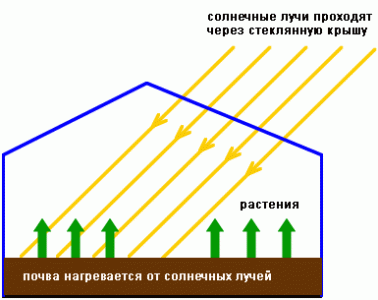

Natural heating of the greenhouse with the help of sunlight
Of course, this heating method cannot be considered complete when it comes to growing crops year-round. Additional heating is required here, which can create a natural greenhouse effect in the cold season. Among the main methods of heating greenhouses, electric, gas and solid fuel options are most often preferred.
There is another way how to heat a polycarbonate greenhouse in winter. These are infrared electric lamps and heaters. These devices are good because they do not dry the air and act like solar energy. As you know, when reaching the surface of the Earth, the sun's rays heat objects and are reflected by heat. Infrared lamps and heaters also work.
If they are placed along the entire length of the greenhouse, under the ceiling, then they will heat the soil, plants, walls, and, reflecting, the heat will accumulate in the room. They are absolutely harmless, with very high efficiency. Because they give a lot of heat, and the energy consumption is low. Such heating can be very easily adjusted to create the desired microclimate in the greenhouse.
Perhaps today this is the safest and most profitable method to heat a greenhouse in winter.
Simple and economical natural heating methods are auxiliary. These are energy from the sun's rays and biofuels.
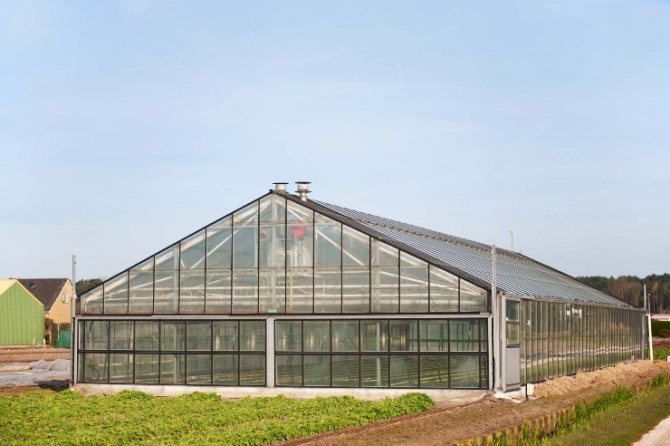

The sun is the most economical form of energy
Solar heating is suitable for regions where the climate is mild and the average winter temperature does not drop below zero. For colder regions, this method is used from March-April. In order for the plants to receive enough light and heat, the greenhouse must be placed in a well-lit area without drafts.
A transparent rounded roof warms up better with the sun's rays. Such an arched shape of greenhouse structures is most resistant to winds and various loads.
The use of biofuels has been proven for centuries. The old folk method is based on the ability of organics to release a large amount of heat during decomposition.Experienced gardeners use this to equip warm beds by mixing pet manure with compost made from rotten straw, bark, grass, leaves, or unusable fruit. Horse manure heats up especially quickly.
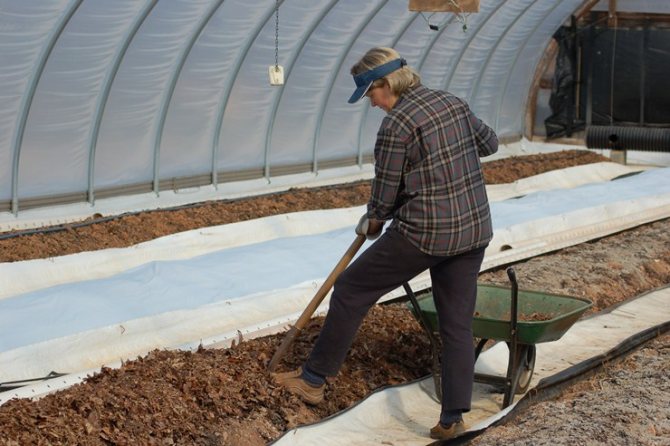

Manure will fertilize, and at the same time insulate the soil
Instead of manure, you can use special dry briquettes that do not have a specific smell, but work just as effectively. To start, biofuel is slightly added to the well-loosened soil. When steam begins to flow from the beds a week later, they can be covered with fertile soil and seedlings can be planted. High warm beds are convenient and practical in terms of caring for them.
Natural cheap methods are auxiliary, because solar energy is not always enough to heat the greenhouse, and biofuel begins to decompose only at a certain temperature regime.
Heating
Depending on where you live, you can decide if you need additional heating. ... Winter greenhouse heating methods:
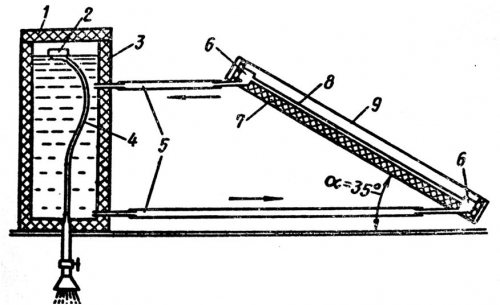

Solar energy. Everyone knows that the air in winter has fairly low temperature indicators. But the sun's rays carry enough heat and energy. Its use is quite effective, low-cost, and most importantly environmentally friendly. The use of polycarbonate helps to diffuse sunlight over the greenhouse space. The sun heats the air to optimal temperatures, and polycarbonate prevents it from escaping. This heating method is effective if you live in an area where the sun in winter is quite frequent, and low temperatures are rare. Is a fairly well-known greenhouse effect. But such heating of greenhouses has a significant drawback - it is impossible to control the sun and the sun's rays. It is also impossible to foresee the level of solar activity. So this method, although effective, is quite unpredictable.


Biological system. This heating method can be called the most ancient, proven, low energy consumption and effective. Everyone is well aware of the fact that biological products generate heat during decay. With their help, you can perfectly heat not only air, but also the top layer of the earth. Biological material can be completely different: horse manure, chicken droppings, tree bark, straw, sawdust and other options. Horse manure is the best option. The fact is that it can warm up to 70 degrees and keep that temperature for about three months. Due to the presence of polycarbonate, such a system very effectively heats the air and the layer of the earth, which is important for the growth of plants and their fruits, for example, cucumbers. In addition, it is possible to create a special material for efficient heating of a greenhouse with your own hands. To do this, it is necessary to lay the following layers: finely chopped straw, lime saltpeter on top. All these layers must be watered with hot water, tamped tightly, and a layer of earth should be poured on top. The result is a biofuel that effectively heats the ground and air in the greenhouse in winter. The main thing - .
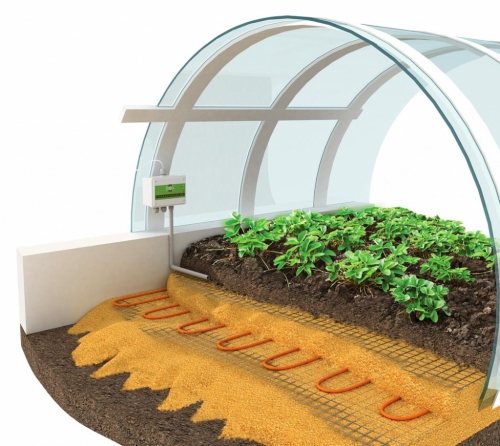

Technical heating of greenhouses. ... In such conditions, the previous two methods of heating a polycarbonate greenhouse will not be a good solution. A winter greenhouse, of course, has some possibilities, but when it is severe frost outside, it is quite difficult to keep high temperatures inside the greenhouse. This is where technical options for heating systems come to the rescue. There is more than one method for technical heating of a winter greenhouse:
- Electric option. If we consider the way in which conventional heaters with a built-in fan will be used, then we can immediately discard this idea. This will consume a lot of energy, and the effect will not turn out to be impressive.For the electrical system to be efficient, to warm the air well in winter indoors, it is necessary to use cables and heating elements. They can be laid not along the perimeter of the greenhouse, but in the ground at a depth of about 40 cm. This heating method is very effective, but you must be prepared for the fact that it will cost a lot in winter;
- Water heating method. This is the same method used in residential buildings. It is quite effective, popular and actively used for heating a winter greenhouse. ... In addition, the installation of such systems is easily done with your own hands. This will require a boiler and piping systems. Pipes can be laid both along the perimeter of the greenhouse, and directly in the ground, on a specially created drainage substrate. Gas, electricity, coal and firewood can be used as fuel for the boiler to heat the water. The fuel is selected depending on the selected type of boiler. It is important to carry out heating of large polycarbonate greenhouses in this way. The costs will be justified, and the system will warm up both the air and the ground well in winter to the required temperatures;
- Greenhouse infrared heating systems. This method is considered the last word in the technological process. To achieve the goal, you can use various types of infrared radiation devices: screens, panels, and lamps. Their advantage lies in the fact that they heat the soil to the required temperatures, and not the air at all. Such methods of heating a polycarbonate greenhouse are energy-efficient. ;
- Stove heating. Yes, this option is also possible. This is one of the ancient heating methods used in some villages. This is a laborious process and, in truth, ineffective. Such heating of greenhouses should not be left unattended and constantly put firewood so that the temperature does not drop below the prescribed limit.


The listed methods of a polycarbonate greenhouse heating system can be created with your own efforts and with your own hands. ... Proper heating of the greenhouse is the key to an excellent harvest that will delight your table in the winter. A winter greenhouse is a great opportunity to fulfill your desires and bring the long-awaited spring a little closer.

